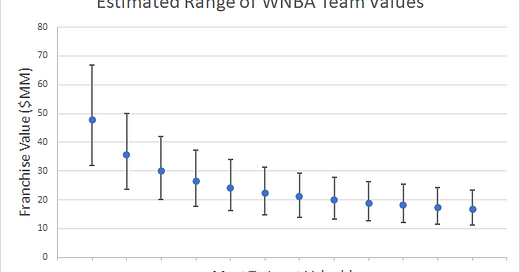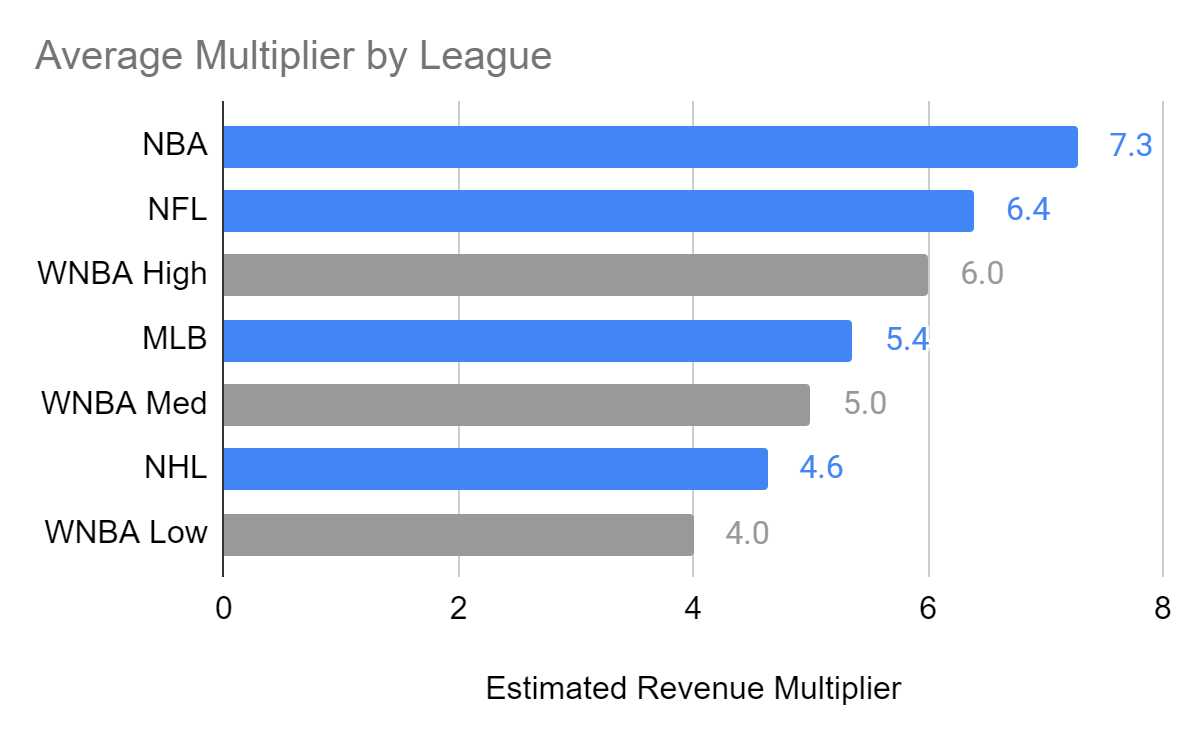What is a WNBA Team Worth?
In the wake of recent reporting surrounding the sale of multiple WNBA teams, the Her Hoop Stats team estimates the potential value of franchises using financial analysis techniques.
Thanks for reading the Her Hoop Stats Newsletter. If you like our work, be sure to check out our stats site, our podcast, and our social media accounts on Twitter, Facebook, and Instagram. You can also buy Her Hoop Stats gear, such as laptop stickers, mugs, and shirts!
Haven’t subscribed to the Her Hoop Stats Newsletter yet?
It may be the offseason, but January has been an exciting month in the WNBA. The league played a key role in the election of Reverend Raphael Warnock; teams made qualifying offers including moves to core Liz Cambage, Nneka Ogwumike, and Natasha Howard; and free agency officially began on January 15. The most important news, however, was probably the official announcement that Mark Davis had reached an agreement to purchase the Las Vegas Aces and that the Atlanta Dream were close to being sold.
The discussion about ownership changes reminded us of a question we’ve had for some time: just how much does it cost to purchase a WNBA team? In other leagues, sales prices have been widely reported. For instance, Ryan Smith just purchased the NBA’s Utah Jazz for a reported $1.66 billion and the NFL’s Carolina Panthers cost a reported $2.275 billion in 2018. Beyond final sale prices, outlets like Forbes report on annual revenues and franchise values that help the public get a sense of potential numbers while negotiations are still underway.
However, we’re not aware of similar reports for the WNBA. Here at Her Hoop Stats, we can’t report on the price for either the Aces or the Dream, but we were curious if we could provide a reasonable range for it. As we’ll detail below, our estimate for the average value of a WNBA team is anywhere from $17 to $35 million, depending on the specific assumptions. The most valuable team could potentially be valued as high as $67 million under an optimistic scenario for the league, while the most affordable team could be valued as low as $11 million in a highly conservative scenario.
As we’ve written up and circulated our analysis, two main questions have been raised. First, would someone really write a check for more than $17 million to purchase the average WNBA team? It is important to keep in mind that the money directly transferred from buyer to seller in a purchase can be quite different than the value of the team (or any financial asset). As an example, think of someone who purchases a new $20,000 car. The value of the car is $20,000 whether the buyer pays the full amount in cash or puts no money down and finances the entire amount. The cash involved in the purchase does not affect the valuation of the car in this example.
Second, some have asked why a WNBA team would have a significant positive value when they are reportedly losing money? There are multiple reasons. Purchasing any business is really about purchasing the total future cash flow of the business. Companies that are losing money today and have never earned a profit are regularly valued highly by investors on the expectation of future growth and corresponding cash flows. Slack and Tesla are recent examples of this phenomenon. In the same way, buyers such as Mark Davis are betting that the league’s future growth will lead to enough future profitability to justify taking on losses in the short term.
Additionally, not all WNBA teams are reportedly losing money. Twin Cities Business reported ahead of the 2019 season that “the Lynx have been profitable since they started winning” per Lynx and Timberwolves CEO Ethan Casson. Back in August 2014, it was reported by Sports Business Daily that “the WNBA expects to see at least six of its 12 teams post a profit for 2014, the same number of clubs as last year”. With the WNBA rights deal with ESPN improving from roughly $12 million annually in 2013 to about $25 million beginning in 2016 and potentially increasing further in the future, it seems quite reasonable to expect more teams could turn a profit in the coming years.
So, how did we calculate our estimate of the value of WNBA teams? We used a financial valuation technique known as a revenue multiplier. One of the methods financial analysts use to value companies is to take their annual revenue and multiply it by a factor known as the multiple. In the aforementioned case of the Utah Jazz, Forbes estimated their 2020 revenue to be $258 million and their value to be $1.55 billion. At a value of $1.66 billion, they sold for 6.4 times their estimated revenue.
With Forbes providing an estimate for the revenue and value of each NBA team, we can use those numbers to find that the average estimated revenue multiple for all NBA teams is 7.3. In fact, we can repeat this calculation for the four major North American men’s professional sports leagues. As the chart below shows, the revenue multiple ranges from 7.3 for the NBA to 4.6 for the NHL. For our analysis, we’ll use a multiplier of 4.0 as a very conservative low-value scenario, 5.0 as a medium value scenario, and 6.0 as a reasonable high-value scenario to ensure our results are not overly optimistic.
With a range of possible revenue multipliers in hand, the next question is what is a reasonable estimate for the WNBA’s total revenue? It was previously reported by David Berri that a “conservative figure” for league revenue was around $60 million several years ago. Given our research, we believe that still appears to be a good moderate estimate for the league’s revenue. Because we are trying to estimate the lower and upper bounds of the value of an average franchise, we will also consider a pessimistic $50 million scenario and a more optimistic $70 million into our range of possibilities. These levels are all assuming a post-pandemic world.
With three scenarios for the revenue multiplier and three for the WNBA’s revenue, we have nine possible combinations for the total value of the league’s 12 franchises, from which we can find nine estimates for the average team’s value. Those combinations are listed below with a lower limit of $17 million and an upper limit of $35 million. Since those are the limits, a moderate estimate for the average franchise value would be around $25 million.
This gives us a sense of the value of an average team, but not every team is created equal. According to Forbes, the New York Knicks are the most valuable NBA team at $4.6 billion dollars while the Memphis Grizzlies are worth only $1.3 billion, almost one-third the value of the Knicks. We don’t know which WNBA teams are the most and least valuable, though one might guess teams such as Seattle and Minnesota might be on the higher end while teams like Atlanta could be among the most affordable teams for a buyer.
We can, however, estimate how values might vary within the WNBA by assuming a roughly similar distribution to that of other leagues. We applied the distribution to each of our nine scenarios to come up with an estimate for how much the most expensive team may be valued under each scenario, how much the least expensive team would cost, and teams in between. The results are presented below with the “Medium-Medium” scenario shown as the blue dot and the range of the upper and lower limits illustrated as well.
Again, these are not estimates for any specific team, but they suggest that the most expensive team in the WNBA could be worth as much as $67 million under an optimistic scenario and is probably worth around $32 million in a conservative scenario. On the other hand, the most affordable WNBA teams might cost around $11 million in that conservative scenario and $23 million in the optimistic scenario.
While no one on the Her Hoop Stats team can afford a WNBA team, LeBron James (net worth of about $450 million) made news when he tweeted about potentially buying the Atlanta Dream. A number of other athletes said they wanted in as well, including Billie Jean King, Mookie Betts, and Carmelo Anthony. The potential for celebrity ownership groups similar to Angel City FC in the NWSL could help create additional interest in buying WNBA teams, driving up their prices even higher as the league grows.
We recognize $17 to $35 million is a wide range, but it is our first attempt at a grounded estimate of the value of an average WNBA team. We’ve developed it without access to the actual financial information that would be disclosed to potential buyers. Ultimately, the value of a franchise is what someone is willing to pay for it based on the information available to them. If the assumptions we have used are different than the reality the buyers know, our estimate of team value will be different as well.
As long as sales prices are not publicly available, our goal is to refine and tighten the estimate to a more specific number through additional reporting about the components of valuing a WNBA team. Additionally, we’ll be working to do our own reporting on the sale prices of teams in the WNBA and no doubt other outlets will as well. We’ll look forward to validating whether or not our rough estimate of WNBA franchise values has been correct.
Thanks for reading the Her Hoop Stats Newsletter. If you like our work, be sure to check out our stats site, our podcast, and our social media accounts on Twitter, Facebook, and Instagram.








There is a sea change coming for the WNBA. With players like Caitlin Clark, Angel Reese, Paige Bueckers and more all coming into the WNBA in the next few years will revolutionize that league. It is similar to what Larry Bird and Magic Johnson did to the NBA. It needed exciting players that demanded eye balls. This group of collegiate athletes are doing the same thing and it will translate into the WNBA. WNBA team valuations will increase as a result.
Now that the sales are complete, can you report how much the Aces and Dream sold for?